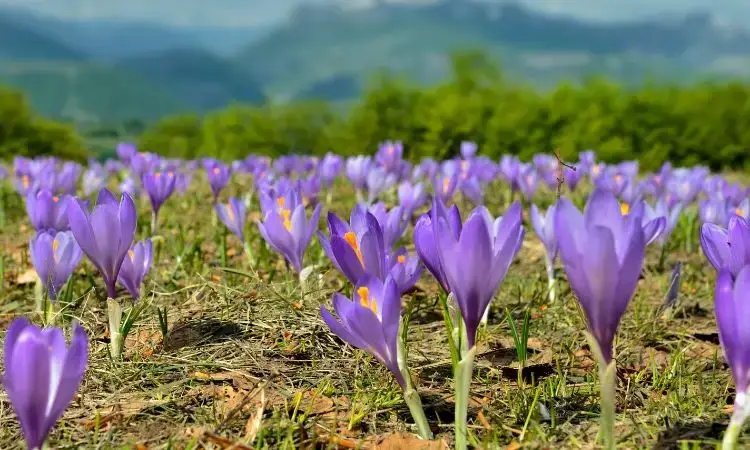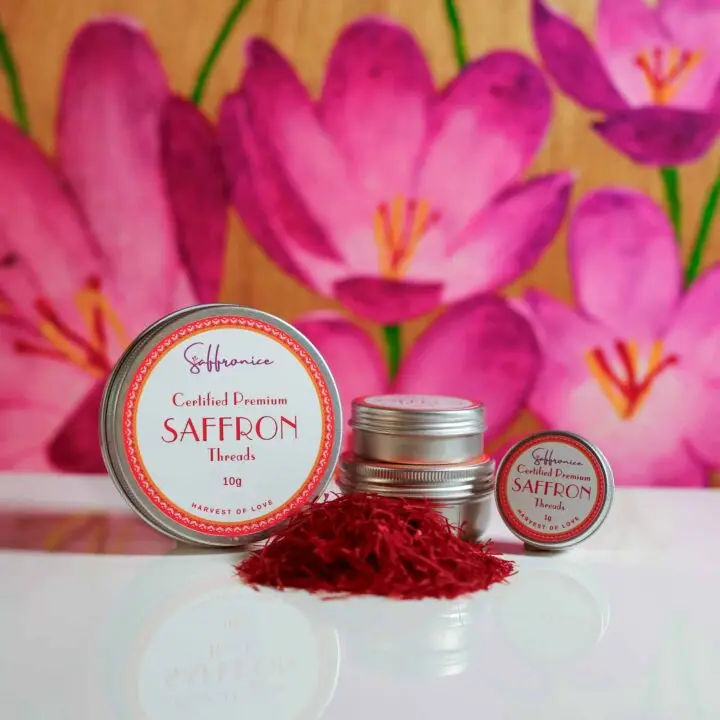Originating from Mediterranean regions, saffron (Crocus sativus) has adapted to specific climatic patterns that growers worldwide must replicate to achieve optimal results. From temperature ranges and precipitation patterns to soil conditions and seasonal timing, every environmental factor plays a critical role in the delicate balance required for thriving saffron crops.
📌 Quick Answer: Saffron thrives in Mediterranean climates with hot, dry summers (25-35°C), cool autumns for flowering (15-20°C), and cold winters (below 10°C) for dormancy. The crop requires 300-600mm annual rainfall, well-drained soil (pH 6.0-8.0), full sun exposure (6+ hours daily), and moderate elevations (500-1,800m). Continental climates work with proper management, but Mediterranean conditions produce the highest quality saffron.
Key Takeaways
- Mediterranean climates with distinct seasons provide ideal saffron growing conditions.
- Temperature ranges must accommodate dormancy, flowering, and growth phases
- Well-drained, slightly alkaline soil (pH 6.0-8.0) prevents common cultivation problems
- Moderate water requirements with strategic irrigation timing optimize yields
- Seasonal timing of planting, dormancy, and harvest directly impacts quality
- Climate control methods protect crops from frost and excessive heat
- Understanding local climate adaptations maximizes regional success

Understanding Saffron Farming Climate Requirements
Successful saffron cultivation begins with comprehensive climate knowledge. This precious spice, derived from Crocus sativus flowers, demands specific environmental conditions that balance temperature, moisture, and seasonal patterns. Understanding these requirements helps growers avoid common saffron growing challenges and optimize production.
Core Climate Parameters
Temperature: The foundation of saffron climate requirements centers on temperature variation across seasons. Saffron needs distinct thermal phases to complete its life cycle successfully.
Moisture Balance: Saffron requires moderate precipitation distributed strategically throughout the year. Too much moisture causes fungal diseases and corm rot, while insufficient water during active growth reduces yields.
Seasonal Distinction: Clear seasonal transitions trigger the physiological processes essential for flowering and corm development. Regions with blurred seasons often produce inferior yields.
Food Scientist’s Note: Saffron’s bioactive compounds—crocin, picrocrocin, and safranal—develop optimally under specific temperature and moisture conditions. Research shows that the concentration of these valuable compounds increases when plants experience moderate water stress during flowering, combined with cool nighttime temperatures. This explains why Mediterranean saffron commands premium prices.
Mediterranean Climate Zones
The Mediterranean climate represents the gold standard for saffron production. This climate pattern, characterized by specific seasonal characteristics, has supported saffron cultivation for millennia.
Mediterranean Climate Characteristics:
Summer (June-August):
- Hot, dry conditions with temperatures s 25-35°C
- Minimal rainfall (10-20mm monthly)
- Low humidity (30-50%)
- Intense solar radiation
- Corm dormancy period
Autumn (September-November):
- Cooling temperatures (15-25°C)
- Moderate rainfall resuming (30-60mm monthly)
- Flower emergence and bloom
- Critical harvest period
Winter (December-February):
- Cool, wet conditions (5-15°C)
- Highest precipitation (60-100mm monthly)
- Vegetative growth phase
- Corm multiplication
Spring (March-May):
- Warming temperatures (10-20°C)
- Declining rainfall
- Foliage maturation
- Transition toward dormancy
Leading Mediterranean Saffron Regions:
- Iran: Produces 90% of global saffron, primarily in Khorasan province
- Spain: The La Mancha region is famous for premium-quality saffron
- Italy: L’Aquila produces highly aromatic Italian saffron
- Greece: The Kozani region is known for its distinctive saffron characteristics
- Morocco: The Taliouine area produces excellent North African saffron
Continental Climate Adaptability
While Mediterranean climates are optimal, saffron successfully adapts to continental climate zones with proper management. Continental climates feature greater temperature extremes and more dramatic seasonal transitions.
Continental Climate Challenges:
Temperature Extremes: Winter temperatures may drop below -15°C, requiring hardy varieties and protective measures
Rapid Seasonal Transitions: Sudden temperature changes stress plants, potentially reducing flower quality
Variable Precipitation: Unpredictable rainfall patterns necessitate controlled irrigation systems
Shorter Growing Seasons: Compressed vegetative growth periods may limit corm multiplication
Adaptation Strategies:
- Select cold-hardy saffron varieties tolerant of temperature extremes
- Implement heavy mulching (10-15cm), protecting corms during harsh winters
- Use raised beds, improve drainage, and warm the soil earlier in spring
- Install irrigation equipment compensating for irregular rainfall
- Time planting precisely to maximize available growing days
- Consider protected cultivation (hoop houses, greenhouses) in extreme climates
Chef’s Professional Tip: I’ve worked with saffron from various climate zones in professional kitchens. While Mediterranean saffron typically offers more intense aroma and deeper color, well-managed continental saffron can produce excellent quality threads. The key difference lies in the concentration of volatile compounds—continental saffron sometimes requires 10-15% more threads to achieve the same flavor intensity as premium Mediterranean varieties.
Optimal Temperature Ranges for Saffron Growth
Temperature management is arguably the most critical factor in saffron cultivation. The plant requires specific temperature ranges during different life cycle phases, and understanding these requirements prevents common cultivation failures.
Dormancy Period Temperature Requirements
Summer Dormancy (June-August):
- Optimal range: 25-35°C daytime
- Nighttime: 15-25°C
- Tolerance: Up to 40°C for short periods
- Critical: Soil must remain dry and warm
During dormancy, saffron corms rest underground, metabolic activity drops to minimal levels, and excessive moisture becomes dangerous. High summer temperatures actually benefit the crop by ensuring corms remain dry and free from fungal infection.
Flowering Stage Temperature Needs
Autumn Flowering (October-November):
- Optimal daytime: 15-20°C
- Optimal nighttime: 10-15°C
- Critical range: Must avoid temperatures above 25°C during flowering
- Frost tolerance: Light frost (down to -5°C) is generally tolerated
Temperature Impact on Flowering:
Too Warm (>25°C): Flowers open rapidly, stigmas dry quickly, harvest window shortens, quality decreases
Optimal Range (15-20°C): Flowers develop slowly, stigmas remain plump and moist, extended harvest window, premium quality
Too Cold (<5°C): Flowering delays or halts, potential flower damage, reduced yields
Chill Hour Requirements: Saffron requires 1,000-1,500 chill hours (temperatures between 0-10°C) during winter to trigger proper spring development and prepare for next season’s flowering. Insufficient chilling results in poor flower production.
Active Growth Temperature Range
Vegetative Growth (December-April):
- Optimal range: 10-18°C
- Tolerance: -10°C to 25°C
- Critical: Consistent cool temperatures promote leaf development
- Corm multiplication: Occurs optimally at 12-16°C
Temperature consistency during vegetative growth matters more than absolute values. Frequent fluctuations stress plants and reduce corm multiplication rates, directly impacting future yields.
Soil Requirements and Preparation
Soil conditions profoundly influence saffron success, with drainage and pH being paramount concerns. Proper soil preparation before planting prevents the most common cultivation problems and establishes the foundation for long-term productivity.
Ideal Soil pH Levels
Saffron prefers slightly alkaline soil with an optimal pH between 7.0-7.5, though the acceptable range extends from 6.0 to 8.0. Outside this range, nutrient availability decreases dramatically, even when nutrients are present in the soil.
pH Management:
Testing: Test soil pH annually before planting season using calibrated meters or laboratory analysis
Raising pH (Acidic Soils): Apply agricultural lime at 2-4 tons per hectare, incorporating 2-3 months before planting
Lowering pH (Alkaline Soils): Add elemental sulfur at 0.5-1.5 tons per hectare or incorporate acidifying organic matter
Monitoring: Retest every 6-12 months and adjust as needed
Food Scientist’s Note: Soil pH affects the ionic form of nutrients in solution. At pH levels above 8.0, iron, manganese, and zinc become increasingly unavailable, leading to chlorosis despite adequate soil concentrations. Saffron’s slightly alkaline preference optimizes phosphorus availability—the most critical nutrient for flower development.
Drainage Requirements
Drainage ranks as the single most important soil characteristic for saffron. Waterlogged soil causes immediate corm rot and represents the leading cause of saffron crop failure worldwide.
Drainage Solutions:
Raised Beds: Elevate planting areas 20-30cm above ground level, creating natural drainage away from corms
Soil Amendments: Incorporate coarse sand (20-30% by volume) and organic matter, improving porosity and water movement
Subsurface Drainage: Install drainage tiles or perforated pipes in heavy clay soils
Site Selection: Choose naturally well-drained locations with slopes facilitating water runoff
Testing Drainage: Dig test holes 30cm deep, fill with water, and observe drainage speed. Water should disappear within 24 hours for suitable saffron sites.
Soil Composition Guidelines
Optimal saffron soil provides a balanced texture supporting both drainage and nutrient retention. The ideal composition resembles well-structured loam with specific characteristics.
Ideal Soil Profile:
Texture: Loamy soil with 40-50% sand, 30-40% silt, 10-20% clay
Organic Matter: 2-4% by weight, providing nutrient reserve and improving structure
Mineral Content: Rich in phosphorus, potassium, and essential micronutrients
Depth: Minimum 20cm of workable soil allowing proper root development
Structure: Crumbly, well-aggregated structure facilitating air and water movement
Preparation Techniques for Sustainable Saffron Farming:
- Deep cultivation (30-40cm), breaking up compacted layers 3-4 months before planting
- Incorporate well-composted organic matter (10-15 tons per hectare)
- Add rock phosphate or bone meal (50-80 kg P₂O₅ per hectare)
- Apply balanced fertilizers based on soil test recommendations
- Allow soil to settle and stabilize for 6-8 weeks before planting
For organic saffron farming operations, natural amendments like compost, green manures, and rock minerals build soil health while meeting certification requirements.
Essential Water and Irrigation Needs
Water management in saffron cultivation requires precision and timing. Understanding saffron irrigation needs prevents both waterlogging damage and drought stress, optimizing plant health and flower production.
Annual Water Requirements
Saffron requires 300-600mm of water annually, distributed strategically across its growing cycle. This moderate requirement makes saffron suitable for water-limited regions when managed properly.
Seasonal Water Distribution:
Summer Dormancy: 0-50mm total (minimal to no irrigation)
Early Autumn (Pre-Flowering): 50-80mm (resuming moisture)
Flowering Period: 30-50mm (consistent but not excessive)
Winter Growth: 150-250mm (highest requirement)
Spring (Pre-Dormancy): 50-100mm (declining toward zero)
Irrigation Methods and Frequency
Modern irrigation systems dramatically improve water efficiency and crop performance compared to traditional methods.
Drip Irrigation (Recommended):
- Water efficiency: 40-50% improvement over flood irrigation
- Emitter spacing: 20-30cm along drip lines
- Flow rate: 1-2 liters per hour per emitter
- Placement: 5-10cm from plant rows
- Automation: Programmable controllers optimizing scheduling
Sprinkler Systems:
- Less efficient than drip (20-30% water loss to evaporation)
- Risk: Wet foliage increases disease pressure
- Timing: Early morning only, allowing rapid drying
- Coverage: Uniform distribution is essential
Irrigation Frequency:
Dormancy: None to minimal (once monthly if extended drought)
Pre-Flowering: Every 5-7 days
Flowering: Every 3-5 days (consistent moisture critical)
Active Growth: Every 4-6 days adjusted for rainfall
Pre-Dormancy: Gradually reduce to zero
Chef’s Professional Tip: Irrigation during the two weeks before flowering critically impacts saffron quality. Consistent moderate moisture during this window produces threads with optimal crocin concentration—the compound responsible for saffron’s coloring power. Irregular watering creates stressed plants that produce smaller stigmas with reduced aromatic intensity.

Seasonal Growing Cycles and Timing
Saffron’s unique reverse growing pattern requires precise seasonal management. Understanding proper timing for planting, dormancy, and harvest separates successful operations from failures.
Planting Season Windows
Optimal Planting Period: Late July through September (varies by climate zone)
Timing Considerations:
- Plant 6-8 weeks before the first expected autumn rains
- Soil temperature should be 20-25°C at planting depth
- Early planting (July-August) establishes roots before flowering
- Late planting (September) may produce smaller first-year yields
Planting Depth and Spacing:
- Depth: 10-15cm from the soil surface to the corm top
- Spacing: 10-15cm between corms, 20-30cm between rows
- Orientation: Growing point upward for optimal emergence
Dormancy Period Management
Summer Dormancy (June-August):
Dormant corms require minimal intervention but proper conditions:
- Cease all irrigation, allowing the soil to dry completely
- Remove any volunteer weeds competing for moisture
- Avoid disturbing the soil around dormant corms
- Monitor for pest activity (rodents attracted to dormant fields)
- Plan and prepare harvest equipment and labor
- Consider light surface cultivation to improve soil aeration
Dormancy Triggers: Rising temperatures above 25°C and decreasing day length signal dormancy onset. Leaves yellow and die back as corms enter the est phase.
Harvest Timing Optimization
Proper saffron harvesting methods depend on precise timing aligned with flowering patterns.
Flowering Period: Typically 2-3 weeks in October-November (varies by location)
Daily Harvest Timing:
- Begin at dawn (5-7 AM optimal)
- Complete before 10 AM when flowers fully open
- Harvest every day during the bloom period
- Pick flowers just as they emerge or are barely opening
Harvest Window Factors:
Temperature: Cool morning temperatures (10-15°C) are optimal for quality
Humidity: Moderate humidity prevents rapid stigma drying
Weather: Avoid harvesting after heavy rain or during storms
Flower Stage: Best quality when flowers are closed or barely opening
Proper harvest timing and immediate processing significantly impact final product quality and market value, directly affecting saffron storage methods and shelf life.
Humidity and Rainfall Considerations
Balancing humidity and rainfall represents a constant challenge in saffron cultivation. Too much moisture invites disease, while insufficient water during critical periods reduces yields.
Optimal Humidity Ranges
Ideal Humidity: 50-70% during active growth periods
Seasonal Humidity Preferences:
Dormancy: Low humidity (30-50%) prevents fungal activation in dormant corms
Flowering: Moderate humidity (50-65%) maintains stigma moisture without promoting disease
Vegetative Growth: Higher humidity is acceptable (60-75%), supporting leaf development
Humidity Challenges:
Excessive Humidity (>80%):
- Increased fungal disease pressure (Fusarium, Rhizoctonia)
- Slower stigma drying post-harvest
- Reduced pollen viability
- Corm rot risk during dormancy
Low Humidity (<40%):
- Rapid stigma drying reduces quality
- Increased irrigation requirements
- Potential water stress during flowering
Rainfall Distribution
Annual Rainfall Requirements: 300-600mm optimally distributed
Ideal Rainfall Pattern:
Summer (Dormancy): Minimal (<50mm total)—excess rain during dormancy causes corm problems
Autumn (Flowering): Moderate (80-120mm)—consistent light rainfall is optimal; heavy rains damage flowers
Winter (Growth): Higher (150-250mm)—supports vigorous vegetative development
Spring (Pre-Dormancy): Declining (50-100mm)—gradual reduction toward dormancy
Rainfall Management:
- Install drainage systems handling excess precipitation.
- Use irrigation to supplement insufficient rainfall
- Monitor weather forecasts, adjusting irrigation schedules
- Consider protective structures (shade cloth, temporary covers) during the critical flowering period
- Implement soil moisture monitoring to prevent both drought and waterlogging
Altitude and Geographical Requirements
Elevation and topography significantly influence microclimate conditions affecting saffron cultivation success.
Elevation Effects on Growth
Optimal Elevation Range: 500-1,800 meters above sea level
Elevation Impacts:
Low Elevations (<500m):
- Warmer temperatures may shorten dormancy
- Higher disease pressure from humidity
- Earlier flowering but potentially lower quality
- Require careful variety selection
Optimal Range (500-1,800m):
- Ideal temperature moderation
- Clear seasonal distinctions
- Reduced disease pressure
- Best quality production
High Elevations (>1,800m):
- Shortened growing season
- Risk of excessive frost damage
- Delayed flowering
- Potential for exceptional quality in protected sites
Topographical Preferences
Ideal Terrain:
Gentle Slopes (2-5% grade):
- Excellent natural drainage
- Reduced frost pockets
- Good air circulation
- Easy mechanization and management
Aspect: South or southeast-facing slopes in the Northern Hemisphere (north or northeast in the Southern Hemisphere) maximize sun exposure
Wind Protection: Natural or planted windbreaks protect flowers during the bloom period
Soil Depth: Areas with deeper soil profiles (>30cm) support better corm development
Light Exposure and Day Length Impact
Sunlight duration and intensity directly affect saffron growth, flowering, and biochemical compound development.
Sunlight Requirements
Minimum Daily Sunlight: 6 hours of direct sunlight exposure
Optimal Sunlight: 8-12 hours daily during active growth
Light Intensity: Full sun without shading produces the highest quality saffron
Photoperiod Sensitivity:
Saffron exhibits photoperiod sensitivity, with flowering triggered by shortening day length in autumn:
Critical Day Length: Flowering initiates when days drop below 12-13 hours
Vegetative Growth: Long days (13-15 hours) promote leaf development and corm multiplication
Dormancy Induction: Increasing day length (>14 hours) combined with rising temperatures triggers dormancy
Light Quality Impact:
Research demonstrates that the light spectrum affects saffron biochemistry. Full-spectrum sunlight optimizes crocin, picrocrocin, and safranal synthesis—the compounds determining saffron quality standards.
Weather Protection and Climate Control Methods
Protecting saffron from weather extremes ensures consistent production and quality across variable seasons.
Frost Protection Strategies
Light Frost Tolerance: Saffron tolerates brief frosts to -5°C
Severe Frost Protection (<-10°C):
Mulching: Apply 5-10cm organic mulch (straw, leaves), protecting corms from deep freezing
Row Covers: Use lightweight fabric covers during forecast frost events
Overhead Irrigation: Run sprinklers during frost, to create g protective ice layer
Smoke Pots: Traditional method of creating a warm air layer (labor-intensive)
Site Selection: Choose locations avoiding frost pockets in valley bottoms
Heat Management Techniques
Excessive Heat (>35°C) Protection:
Shade Structures: Install 30-40% shade cloth during heat waves, reducing temperatures 5-8°C
Reflective Mulch: Light-colored mulches reflect heat away from the soil surface
Irrigation Timing: Irrigate early morning, cooling the soil before peak heat
Evaporative Cooling: Micro-sprinkler systems create cooling through evaporation
Variety Selection: Choose heat-tolerant cultivars for warmer regions
Frequently Asked Questions
What climate zone is best for growing saffron?
Mediterranean climate zones with hot, dry summers (25-35°C), cool autumns for flowering (15-20°C), and cold winters provide optimal conditions. However, saffron adapts successfully to continental climates with proper management, including irrigation systems, mulching, and variety selection. The key requirements are distinct seasons with summer dormancy, autumn flowering conditions, and winter chill periods.
Can saffron grow in tropical climates?
Saffron struggles in tropical climates lacking distinct seasons and cool winter periods. The crop requires 1,000-1,500 chill hours (0-10°C) during winter to trigger proper flowering. Tropical regions with high year-round temperatures and humidity create excessive disease pressure and prevent the dormancy period essential for saffron’s life cycle. High-elevation tropical areas with cooler temperatures may work but require extensive testing.
What temperature kills saffron plants?
Saffron corms tolerate extreme cold (down to -20°C when dormant and well-mulched), but flowering plants suffer damage below -10°C. During active growth, prolonged exposure above 35°C stresses plants, reducing yields. The most critical temperature sensitivity occurs during flowering—temperatures above 25°C during bloom rapidly decrease flower and stigma quality. Sudden temperature swings stress plants more than absolute extremes.
How much rainfall does saffron need annually?
Saffron requires 300-600mm of annual rainfall distributed strategically across seasons. Summer dormancy needs minimal rain (<50mm), flowering period needs moderate moisture (30-50mm), winter vegetative growth requires the most (150-250mm), and spring needs declining amounts (50-100mm). Regions with different rainfall patterns can be supplemented with irrigation, making saffron adaptable to various climates when water management is controlled.
Does saffron need full sun or partial shade?
Saffron requires full sun exposure—minimum 6 hours daily, optimally 8-12 hours during active growth. The plant’s biochemistry depends on strong sunlight to synthesize crocin, picrocrocin, and safranal (the valuable compounds). Shaded saffron produces smaller flowers, thinner stigmas, and lower concentrations of key compounds. Only use shade protection temporarily during extreme heat waves exceeding 35°C.
What is the best soil type for saffron cultivation?
Well-drained loamy soil with pH 6.0-8.0 (optimal 7.0-7.5) works best. The ideal composition includes 40-50% sand, 30-40% silt, and 10-20% clay with 2-4% organic matter. Drainage is paramount—waterlogged soil causes immediate corm rot and crop failure. Sandy loam provides excellent drainage but requires more frequent irrigation, while clay loam needs amendment with sand and organic matter to improve drainage and structure.
How do I protect saffron from excessive humidity?
Maintain good air circulation through proper plant spacing (10-15cm between corms), avoid overhead irrigation during flowering, ensure excellent soil drainage, consider raised beds in humid climates, use fungicide treatments preventatively (organic options like copper or sulfur), remove plant debris, reducing disease habitat, and select planting sites with good natural airflow. In persistently humid regions, protected cultivation with ventilation control may be necessary for commercial-quality production.
Conclusion
Mastering saffron farming climate requirements provides the foundation for the successful cultivation of this precious spice. From Mediterranean ideals to continental adaptations, understanding how temperature, precipitation, humidity, soil conditions, and seasonal timing interact determines production success. While saffron demands specific conditions, its adaptability to diverse climates—when properly managed—makes cultivation possible across surprisingly varied regions.
The key to climate success lies in replicating or adapting to the Mediterranean pattern: hot, dry summers for dormancy; cool, moist autumns for flowering; cold, wet winters for growth; and warm, drying springs transitioning toward dormancy. Whether through natural climate advantages or management interventions including irrigation, drainage, frost protection, and heat management, creating these conditions optimizes both yield and quality.
For those committed to saffron farming profitability, climate mastery isn’t optional—it’s essential. The difference between premium saffron commanding top prices and inferior threads worth far less often traces directly to climate management decisions. By understanding and implementing proper climate practices, growers position themselves to produce exceptional saffron that rivals the best saffron available commercially.
Success in saffron cultivation ultimately depends on matching climate capabilities with crop requirements, adapting practices to local conditions, and consistently maintaining the environmental balance that this temperamental yet rewarding crop demands.



